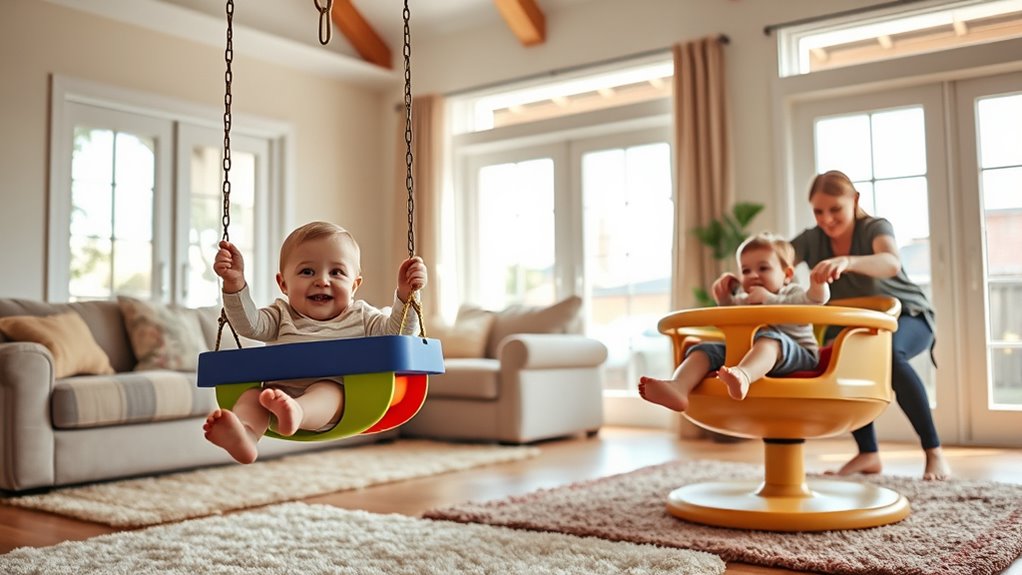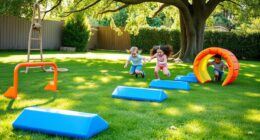To safely incorporate vestibular input at home, you can try activities like spinning or swinging while closely supervising your child. Use soft mats or safety straps and make certain equipment is in good condition to prevent accidents. Start slow with brief sessions, watch for signs of overwhelm, and stop if needed. Adjust the activity intensity to match your child’s comfort. If you keep safety in mind, these fun activities can become effective tools for your child’s sensory development—and there’s more to discover on how to do it best.
Key Takeaways
- Supervise all spinning and swinging activities closely to prevent falls and injuries.
- Use soft mats or cushioned flooring around activity areas for added safety.
- Start with gentle, brief sessions and gradually increase duration based on the child’s response.
- Ensure equipment like swings and spinning discs are well-maintained and secure before use.
- Tailor activity intensity and duration to the child’s comfort, stopping immediately if they show signs of distress.

If your child struggles with balance, coordination, or sensory processing, incorporating vestibular input at home can make a significant difference. One effective way to do this is through engaging balance activities that promote sensory integration. These activities help your child develop a stronger sense of spatial awareness and improve their ability to process sensory information. Simple exercises like standing on one foot, walking along a line, or balancing on a cushion challenge their stability and strengthen their core muscles. As you incorporate these balance activities into daily routines, your child gradually learns to better interpret vestibular signals, which can translate into improved coordination and confidence.
Spinning and swinging are classic vestibular input activities that provide powerful sensory stimulation, but safety is paramount. When introducing spinning, start slowly and keep sessions brief—perhaps a few seconds at first—and gradually increase duration as your child’s tolerance builds. Use sturdy, age-appropriate chairs, stools, or spin discs designed specifically for sensory integration. Always supervise closely to prevent falls or injuries, and ensure the spinning area is free of obstacles. For swinging, choose a well-maintained swing set or a therapy swing that provides secure support. Sit facing your child and gently push or sway to control the intensity of the movement. Remember, the goal is to provide just enough vestibular input to be beneficial without overwhelming your child.
Safety precautions should always be a priority. Make sure the area around swinging and spinning activities is cushioned with mats or soft flooring to minimize injury risk. Never leave your child unattended during these activities, especially if they have difficulty with balance or coordination. Use harnesses or safety straps if necessary, and regularly inspect equipment for wear and tear. It’s essential to observe your child’s reactions—if they seem overwhelmed, dizzy, or upset, stop the activity immediately and give them time to recover. Keep sessions short and frequent, and always follow your child’s cues for comfort and tolerance.
Incorporating vestibular input at home through these activities can be fun and highly effective, but it’s crucial to tailor the intensity and duration to your child’s needs. With careful planning and safety measures in place, you can provide meaningful sensory experiences that promote better balance, coordination, and sensory integration. Over time, these activities can help your child feel more confident navigating their environment and managing sensory challenges more effectively.
Frequently Asked Questions
What Are the Signs of Over-Stimulation From Vestibular Activities?
If you notice signs of sensory overload or behavioral changes after vestibular activities, your child might be overstimulated. Look for signs like irritability, difficulty calming down, or withdrawal. They may also display dizziness, nausea, or clumsiness. These reactions indicate they’ve received too much vestibular input. To prevent overstimulation, watch for these signs and give them time to rest or engage in calming activities.
How Can I Adapt Activities for Different Age Groups?
Think of adapting activities like tuning a radio to just the right station. For different age groups, choose age-appropriate activities that match their developmental considerations. For young children, gentle swinging or rocking works best, while older kids can handle more active spinning or swinging. Always monitor their responses and adjust intensity to guarantee safety and comfort, making vestibular input both fun and suitable for each developmental stage.
Are There Any Contraindications for Vestibular Exercises?
You should avoid contraindicated exercises if you have medical considerations like inner ear infections, migraines, or balance issues. Always consult a healthcare professional before starting vestibular activities, especially if you experience dizziness, nausea, or vertigo. These symptoms can indicate that certain exercises are unsuitable for you. Listening to your body and following medical advice ensures safety while engaging in vestibular input at home.
How Do I Create a Safe Environment for Spinning Activities?
To create a safe environment for spinning activities, you should choose a clutter-free space with soft flooring or mats to prevent injuries. Guarantee supervision at all times, especially for balance enhancement and sensory integration. Use sturdy, secure equipment, and set clear boundaries to avoid falls. Keep the area well-lit and remove sharp objects. This setup helps your child enjoy vestibular input while minimizing risks, promoting safe, effective sensory development.
What Are Alternative Vestibular Activities for Limited Space?
You can try alternative vestibular activities like jumping on a mini trampoline or using a balance board, which require limited space but still provide effective sensory input. These activities help improve balance and coordination while being safe at home. Make sure to supervise closely, especially on the trampoline, and verify the area is clear of obstacles. Incorporating these options allows fun, safe vestibular stimulation even in small spaces.
Conclusion
By incorporating simple spinning, swinging, and movement activities into your daily routine, you create a playground of support right at home. Remember, your efforts are the steady heartbeat guiding your loved one’s growth and confidence. Just like a gentle compass, your vestibular input helps navigate their world with balance and joy. Keep nurturing their senses—your love and consistency are the steady winds that carry them toward a brighter, more balanced future.









